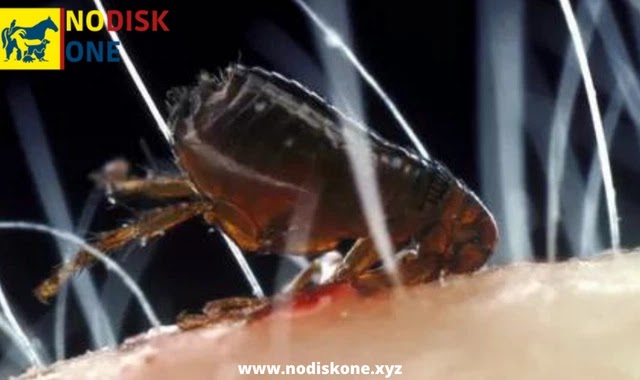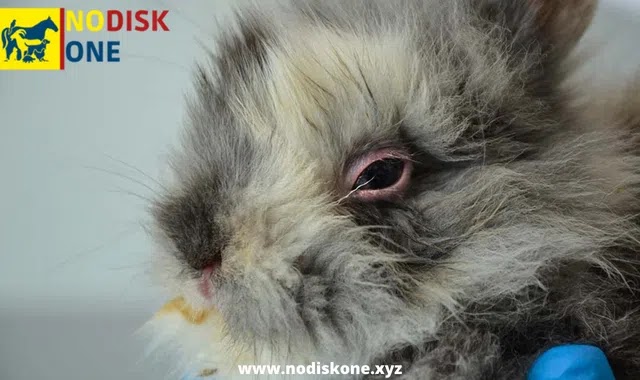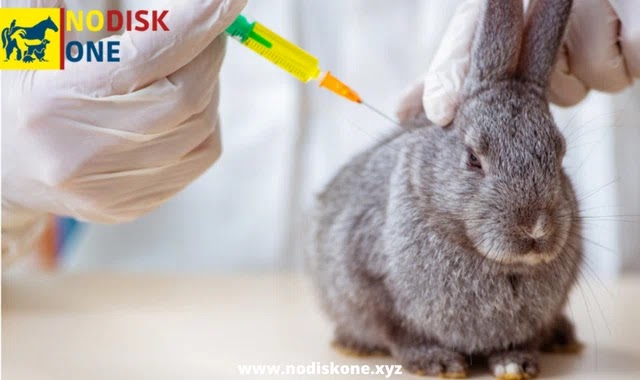Myxomatosis, sometimes referred to as myxi, is a serious viral disease that manifests with severe symptoms in pet rabbits, such as fever, lethargy and eye inflammation. Unlike bacterial infections which can be successfully treated with antibiotics, myxomatosis is not easily cured and is often rapidly fatal. There is no specific treatment and supportive care is only occasionally successful in helping rabbits recover. However, preventative measures such as vaccinations, flea repellents, and keeping your rabbit away from potentially infected rabbits can help avoid myxomatosis.
 |
| Myxomatosis In Rabbits: Everything You Need To Know About Myxomatosis |
The fatal and painful disease myxomatosis affects rabbits all over the world. At Nodisk One we take a look at what myxomatosis is, what happens if a rabbit gets myxomatosis. We find out how to deal with this problem and what preventative measures you can take to keep your rabbit healthy.
This is an informative article. Nodisk One is not permitted to make a diagnosis or recommend any form of veterinary care. If your pet is in pain or ill, we recommend that you take him to the vet.
What Is Myxomatosis?
The Myxoma virus is the disease that causes myxomatosis. Myxoma is a smallpox virus that originates from wild rabbits in North and South America. The virus causes mild illness in these species, but is fatal to other types of rabbits, including pet rabbits. Between the 18th and 20th centuries, different countries introduced myxomatosis in an attempt to control the population of wild rabbits. It worked.
 |
| What Is Myxomatosis? |
However, in some cases it has also harmed other animal populations, including the Iberian lynx and the Spanish imperial eagle, which have been pushed to the brink of extinction. These species eat rabbits exclusively, and the decimation of the wild rabbit population has eliminated their food source.
Most vaccinated rabbits will not get myxomatosis, and those that do get it will only have a mild form and have a good chance of recovery. Myxomatosis also caused economic damage to the rabbit fur and meat industries, when the disease spread to the domestic rabbit population. Skin damage rendered the fur of farmed rabbits unusable, and disease rendered their meat unfit for consumption.
Diagnosing Myxomatosis In Rabbits
Diagnosis of myxomatosis in a live rabbit is based on a veterinarian's recognition of classic symptoms, blood and urine tests to detect the virus, and biopsies of myxomas. But, because the disease is so rapidly fatal in most cases, a diagnosis is more frequently made by a post-mortem examination.
Causes Of Myxomatosis
 |
| The Spilopsyllus Cuniculi is a major vector of myxomatosis in the United Kingdom. |
This pox virus is transmitted by blood-sucking insects, but can rarely be transmitted by contact with an infected rabbit. Carriers of the virus include:
- The rabbit flea.
- Mosquitoes, mites, lice and flies.
- Infected rabbits (less common).
Symptoms Of Myxomatosis In Rabbits
 |
| Symptoms Of Myxomatosis In Rabbits |
It can take three to 21 days for signs of rabbit myxomatosis to appear. Symptoms are usually mild before worsening for three to five days. Here are the warning symptoms that your rabbit has myxomatosis:
- Red eyelids and eyes.
- Discharge from the nose and eyes.
- Swollen eyelids, nose, lips, ears, face, or genital area.
- Skin lumps or nodules.
- droopy ears.
- Purple spots on the skin.
- Lethargy.
- Fever.
- Reduced appetite.
- Weightloss.
- Difficulty breathing.
- Seizures.
- Coma.
Rabbits that contract myxomatosis can suddenly become very sick. If a rabbit shows symptoms, it is not uncommon for the animal to die within 48 hours.
If your rabbit exhibits any of the following symptoms, consult your veterinarian immediately.
Stages Of Development Of Myxomatosis In Rabbits
In your own pet rabbits, you may not notice the first signs of myxomatosis. During the initial incubation period, they are frequently undetectable. The very first sign is often a skin lesion at the site of an insect bite where the virus begins to replicate. This very first lump or swelling of the skin is usually ignored by even the most observant rabbit breeders.
 |
| Stages Of Development Of Myxomatosis In Rabbits |
The Next Sign Is A Slight Swelling Of The Eyelids
They thicken and turn red with inflammation. You may notice that the eyes become infected and a discharge becomes apparent at this time. The eyes are sometimes described as looking "sleepy" at this initial stage.
Around this time, you may also notice that your rabbit is not behaving as it normally would. They might become drowsy or more reclusive, as well as less active. A change in appetite is often noticed in your rabbit who does not want to eat or drink as much as usual.
The Eyes Keep Getting Worse Over The Following Few Days
At the same time, other bumps and bumps begin to appear around the head. These swollen areas typically appear on the face, around the eyes, at the base of the ears, on the lips and nose. The head takes on a generally bloated and puffy appearance giving the classic look of a rabbit with myxomatosis.
If you gently examine your rabbit underneath, you'll likely see distinct swelling in the genitals and anus. Signs of general lethargy and lack of appetite will also become more pronounced, with your rabbit not wanting to eat much or drink at all. Other lumpy skin lesions can also appear anywhere on the body.
A Rabbit With Full-Blown Myxomatosis Will Look Extremely Sick
They have swollen heads and faces. Their eyelids may become so swollen that they can't open them at all. This means that the rabbit effectively becomes blind. There may also be an unpleasant creamy discharge from the eyes and nose. Some of the skin lesions may start to ooze and become crusty.
Secondary Complications
A rabbit with fully developed myxomatosis may have difficulty breathing due to swelling around the nose. Pneumonia and other secondary illnesses are common if a rabbit develops myxomatosis. They are therefore extremely vulnerable to developing complications from other illnesses as a result of their weakened state. If a wild or unvaccinated rabbit has myxomatosis, the prognosis is extremely poor and euthanasia is often the gentlest way to prevent suffering.
If a rabbit survives, the lumpy skin lesions may probably turn hard and crusty. Eventually, the lumps dry out and fall off. Typically, these skin lesions leave scars, particularly near the eyes and nose.
Unvaccinated Rabbits Die Within 2-3 Weeks
However, if a rabbit has already been vaccinated against myxomatosis, it may succumb to a more chronic but milder form of the disease. Skin lesions tend to be the major sign of this and can lead to scarring if the rabbit survives.
 |
| Unvaccinated Rabbits Die Within 2-3 Weeks |
In this atypical form of myxomatosis, the skin may show circular crusty lesions that may look quite red and raw. Eventually, these areas overlap and then fall off, with the rabbit having a good chance of recovering. With this milder form of myxomatosis, your rabbit will still be very sick and susceptible to secondary problems. Good veterinary care is therefore essential to give your pet the best chance of overcoming the disease.
Prevent Myxomatosis
Since myxomatosis is such a serious disease, vaccination is recommended to help reduce the severity of the disease. It will also give your rabbit a better chance of survival if it contracts myxomatosis. However, since vaccination is not 100% effective in preventing myxomatosis, other precautions should also be taken.
 |
| Prevent Myxomatosis |
This includes ensuring that your pet rabbits are not in contact with wild rabbits. You can also use a product suitable for rabbits recommended by your veterinarian to control fleas, which can carry the disease. Since mosquitoes can also transmit myxomatosis when they bite, this will help ensure that there is no standing water for mosquitoes to breed around your rabbit's environment. Also use a mosquito net on the hutch if necessary.
Remember that if you ever catch a wild rabbit that appears to have myxomatosis, you should ideally wear gloves when handling it. Then, quickly bring them to your local veterinary office. If you have your own rabbits at home, change clothes and wash your hands thoroughly before handling your own animals again. You could carry the virus home on your hands or clothes. You won't have a problem with this, but it might hurt your own rabbits.
Related Questions About Myxomatosis In Rabbits Myxomatosis In Rabbits
How is myxomatosis spread?
Myxomatosis is spread by rabbit fleas and other biting insects. A sick rabbit can also transmit the virus to other rabbits through nasal and ocular secretions, as well as other bodily fluids.
The myxomatosis virus can also be transmitted through direct skin contact, water bottles, food bowls, toys, a rabbit's hutch, etc. Humans cannot contract myxomatosis, but we can transmit the virus from rabbit to rabbit through touch.
What is the incubation period for myxomatosis?
The incubation period can vary considerably. An infected rabbit can begin showing symptoms of myxomatosis in as little as three days or as many as twenty-one.
What is the prognosis for a domestic rabbit with myxomatosis?
Myxomatosis in rabbits is almost always fatal. Some wild rabbits have evolved to resist the virus, but not domestic rabbits. Pet rabbits in myxomatosis-endemic regions should receive vaccinations. Although vaccines are not foolproof, a vaccinated rabbit that contracts the virus will have a good chance of recovering with veterinary care. However, unvaccinated rabbits with myxomatosis will almost never survive.
How is myxomatosis treated?
There is no cure for myxomatosis. Depending on the level of suffering, many veterinarians will recommend euthanasia for unvaccinated rabbits that get myxomatosis.
Vaccinated rabbits can still contract the disease, but in a milder form. If your vaccinated rabbit catches myxomatosis, your veterinarian can offer supportive care to help your rabbit recover.
What breeds of rabbit are affected?
Myxomatosis can affect rabbits of all breeds. Despite having its origins in the wild rabbit population, the disease now affects both wild and domesticated rabbits. Any unvaccinated rabbit can catch myxomatosis.
Can my other pets get myxomatosis?
No. Myxomatosis only affects rabbits.
Is myxomatosis contagious for humans?
No. Humans cannot catch myxomatosis. Be sure to wash your hands before and after handling your rabbits because we can spread it from one rabbit to another.
How can the disease be controlled?
Myxomatosis can best be avoided through vaccination. In some areas where the disease is prevalent, veterinarians may vaccinate up to every six months. If your veterinarian recommends this vaccination, it is important that your rabbit receives it.
When to contact your veterinarian?
Contact your veterinarian any time you suspect your rabbit is unwell. Rabbits are prey and hide their symptoms as best they can.
Be alert for lumps, swelling, and discharge coming from the nose or eyes. If your rabbit displays signs of lethargy and loss of appetite, a trip to the veterinarian is necessary. These symptoms can be indicators of a wide range of serious illnesses. Even if it isn't myxomatosis, it can still be very serious.
If your rabbit shows symptoms of myxomatosis, contact your veterinarian for a definitive diagnosis.
In Conclusion: Myxomatosis And Your Pet Rabbit
Myxomatosis is a deadly disease that affects both wild and domestic rabbits. There is no cure, and most rabbits that catch this virus will die. Vaccination can keep your rabbits safe. Most vaccinated rabbits will not get myxomatosis, and those that do get it will only have a mild form and have a good chance of recovery.
 |
| In Conclusion: Myxomatosis And Your Pet Rabbit |
Myxomatosis only affects rabbits. It cannot infect humans or other pets. However, it can also be spread by humans and wild birds in addition to other animals. Depending on where you live, your veterinarian may recommend different vaccinations for your rabbits. In some parts of the world, veterinarians offer a vaccine against myxomatosis. If your veterinarian suggests this vaccine for your rabbit, take it. Myxomatosis is a fatal disease in wild rabbits and pet rabbits.
Only credible sources, such as peer-reviewed studies, are used by Nodisk One to substantiate the information in our articles.

Comments